Here’s How You Can Skate on Wild Ice
It’s the time of year to hunt for that ephemeral winter gold—black ice—or to plan a trip to one of these destinations where tracks are groomed all winter on wild, natural ice.
When I think of skating in Ottawa, I still think of the light. In the long and early golden hour, the Canadian city and its opaque ice take on a sort of rosiness. It’s cold and the days are short, but the magic of being able to move for miles through an urban landscape on skates is infectious.
Come late December or early January, the Rideau Canal, which runs through the heart of Canada’s capital city, becomes the Rideau Skateway. For three months, the city grooms the ice at night so its residents can skate for fun (or commute) by day. At 7.8 kilometers in length, running from downtown to Dow’s Lake (which you can also skate) the canal currently holds the record for the world’s largest natural ice rink.
I first discovered canal skating as a student at St. Lawrence University in Canton, N.Y. My friends and I used to make annual skating trips to Ottawa, which was about an hour and a half’s drive from school, across the St. Lawrence River.
Often these trips coincided with the coldest days of the year. Stir crazy and undaunted by sub-zero temperatures, we happily donned three pairs of socks and wrapped ourselves in scarves, sweaters and coats to spend the day outdoors. It was always a welcome treat during the depths of a north country winter.
After renting skates and stashing our street shoes at the canal’s downtown Rideau entrance,
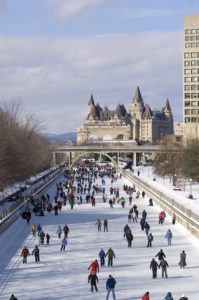
we would glide for hours. Though I’m no expert skater, I loved gliding through Ottawa, watching the city pass by. We passed skating parents pushing kids in sleds, grandparents pushing stabilizing carts, young people laughing with their friends and people hopping on and off the frozen canal as though they were getting off at a bus stop. At some point our fingers would get cold and we’d stop at an on-ice coffee shop for a hot drink.
Skating is a big part of the culture of Ottawa. On average, Ottawa Tourism reports more than 2,000 people skate the canal each day. Along the canal vendors sell hot waffles and poutine along with coffee and, in some places, beer. I still remember trying a beaver tail, one of Ottawa’s signature treats on my first trip to the skateway. Deep fried in hot oil, it’s a decadent pastry that is soft on the inside and crispy on the outside and made with whole wheat flour. It’s typically sprinkled with butter and sweet toppings like cinnamon sugar, jam or honey and occasionally maple syrup.
But there was no treat so satisfying as hot poutine. After skating for eight miles in negative 20-degree weather, we felt we’d earned a heaping portion of hand-cut French fries loaded with melting cheddar cheese curds and topped with hot gravy. They disappeared fast.
Post poutine, with frozen toes and warm bellies, we returned our skates and searched for a pub in the late afternoon light. When we found one a few blocks away from the canal, it was packed with revelers and hockey fans. After a round of Canadian beers, we walked back to our car to head back to campus. Our faces were rosy and we felt like we’d made the most of a blisteringly cold day. My roommate had discovered she could still land an axel and I had only fallen once trying to keep up with her on my hockey skates.
The skating was so good, that I made a point to return annually for Winterlude, a festival that celebrates Canadian culture and winter. Much of the festival takes place on the skateway or just off of it. Highlights for 2019 include the International Ice Carving Competition, where you can watch carvers create massive ice sculptures of insects, mythological creatures, castles and monsters. There’s also a skate-ski-run triathlon on the frozen canal, an ice Dragon Boat Festival and an on-ice hospital bed race. This year’s festival will run from Feb. 2 to Feb. 19.
Skating through Ottawa turned me on to the sport. The motion of pushing and gliding across ice for miles at a time is both relaxing and exhilarating. I found there was really no comparison between skating outdoors and skating indoors on an oval rink and I began to look for other destinations where I could skate in the wild. While November and December can turn up some of the best wild black ice, there are not many places that actually groom all winter for skaters. Here’s are a few other wild skating destinations to check out.
Lake Morey, Fairlee, Vt.
It’s morning. The air is crisp and cold, and snowflakes are just starting to fall. As you strap your skates on by the shore, a groomed path of pristine ice stretches before you on Lake Morey in the Upper Valley. Skates on, you push and glide out onto the lake as clouds part briefly for a view of the neighboring mountains.
For the last 12 years, dedicated locals have used four-wheelers to clear snow and groom a 4.5-mile skating loop around the lake’s perimeter, along with a series of hockey rinks. The Lake Morey Resort took over grooming about 10 years ago and now partners with the Upper Valley Trails Alliance to maintain the trail. Skating on the groomed loop is free and open to the
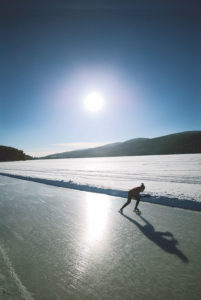
public. It typically opens in late December and runs through February.
“On a beautiful Saturday or Sunday, it’s common to see upwards of 1,000 people out on the ice,” says Christine Cecchetti, director of business development for Lake Morey Resort. “It’s really cool to look out after school and see the kids out playing pick-up hockey,” she says.
Skating at Lake Morey can be either solitary or social. Cecchetti recommends touring the lake on Nordic skates, which are available for rent onsite along with figure skates and hockey skates. “Natural ice is very different from indoor ice. There can be bumps and bubbles, even in black ice, and these skates glide over cracks really effectively and are meant for traveling longer distances.”
Cecchetti says distance skating is a great workout. “It’s phenomenal for your glutes and quads and it’s a great cardio workout. Plus, skating outdoors is invigorating,” she says. “It gives you a real sense of life, of accomplishment. Snow conditions may be iffy, but at Lake Morey, we always seem to have ice. We like to boast, ‘Don’t hibernate, celebrate winter.’” Events on the lake for this winter include the 15th annual Lake Morey Skate-a-thon (Jan. 12), where skaters challenge themselves to skate as many laps in a day as they can and the Vermont Pond Hockey Championships from Feb. 1-2, as well as Winter Carnival on Feb. 15, which includes a large open-air, on-ice market with New England craft goods, food and beer. lakemoreyresort.com
Squam Lake, Sandwich, N.H.
Just below New Hampshire’s Sandwich Range lies Squam Lake, a nine-mile lake marked by tendril-like inlets as well as coves and islands. Beyond its rocky shores rise the tall peaks of the White Mountains. Much of the skating here is wild, except for a set of hockey rinks and a groomed loop maintained by the Squam Lakes Association (through President’s Day) in Piper Cove, the bay that houses the town of Holderness.
According to Rebecca Hanson of the Squam Lakes Association, the start of skating season typically depends on the weather, but is often sometime after the new year. However, the lake is known to develop early season black ice. Each February, the Squam Lakes Association hosts Winterfest, an open-air festival that features open pond hockey scrimmages, groomed skating, a chili competition and on-ice mini golf in Piper Bay. This year’s event, the 23rd annual, will run on February 15. “It is a super family-friendly affair,” says Hanson. “We draw a couple of hundred people every year, and it’s always great to see people get outside in the winter.”
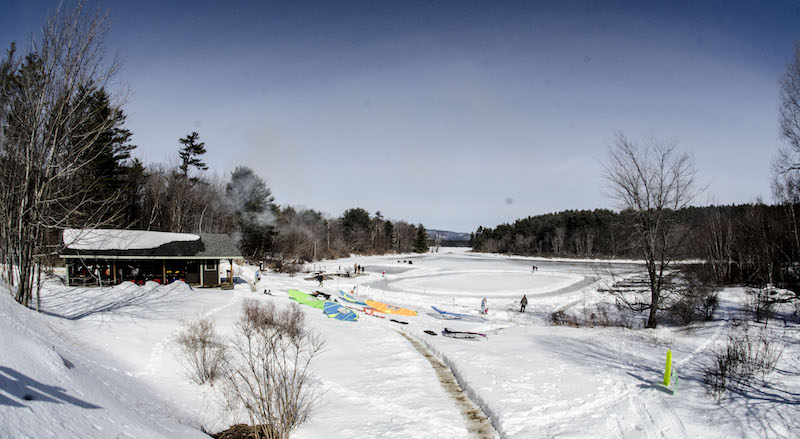
Most of the skating at Squam Lake is on wild ice, where skaters should assess the ice thickness and safety for themselves. It’s a good idea to have ice claws, a test pole and a throw bag any time you set out to skate on wild ice. If you are new, go out with someone more knowledgeable than you are and to always travel in groups of more than one person when skating this way. squamlakes.org
Mirror Lake, Lake Placid, N.Y.
In the depths of winter, New York’s Adirondacks are rugged, cold and beautiful. And at the heart of the Adirondack town of Lake Placid lies Mirror Lake, a small but picturesque body of water that freezes over regularly. Because of its location in the village, it’s historically been popular with cross country skiers, snowshoers and pond hockey players. Skating has been documented there for more than 100 years.
Since 2013, the community has maintained a skating track that circumnavigates the two-mile-long lake. Through a local fundraising effort, the community raised money to purchase high-end outdoor grooming equipment, which allows them to clear snow quickly and keep the track groomed for extra smooth ice. The equipment requires at least six inches of ice to operate, which means the skating season typically starts in January.
The town also grooms a few hockey rinks near the town beach. All skating facilities are free and popular. On a given day, dogsleds, cross country skiers and skaters all share the lake’s surface. Skaters get the track to themselves. Skate rentals are available at Lake Placid Skate Rentals, next to the Golden Arrow Hotel on Main Street.
The Mirror Lake loop is the perfect place to try open air skating on a surface that is solid and safe, but still offers a high mountain skating experience. The surrounding region offers plenty of wild ice, but much of it is either remote or difficult to assess for safety or both. At Mirror Lake, you can skate against the backdrop of some of the tallest peaks in the East and still be within walking distance of downtown Lake Placid’s cafes, bars and restaurants. lakeplacid.com
Finding Wild Ice
January and February can offer terrific skating in the northeast. If you are savvy and know where to look, you can sometimes find Vermont ponds frozen so strong and so clear that you can watch aquatic plants move beneath your feet. This is black ice, usually the first layer to form for the season. It’s smooth and glassy and spooky, and it’s ephemeral. According to veteran Vermont skater and ice boater Bob Dill, it can appear over a night or two and disappear in a day.
Dill, who uses his engineering background to analyze, forecast and blog about Vermont’s lake ice (at lakeice.squarespace.com), says that contrary to what you might think, the first lakes to freeze are typically at low altitude. “In the Champlain Valley, we generally get black ice on ponds early in the season. Typically, it happens in early December,” says Dill. Black ice requires calm weather and sustained freezing temperatures over two or more days without snow to develop.
Dill says those conditions are more likely to occur in Vermont’s valleys than in the mountains because higher elevation lakes and ponds are more likely to see snow when the temperature drops, and snow ruins the quality of black ice. Near Burlington, Colchester, Shelburne, Deerfield, Monkton and Bristol Ponds are all excellent early season skating sites. For more advanced skating that requires reading ice for weak points, Dill says that Lake Champlain typically freezes south of the Lake Champlain Bridge, which goes from Addison, Vt. to Crown Point, N.Y., in late December or early January. Skaters should be advised that there is a current there and thin ice can appear seemingly out of nowhere.
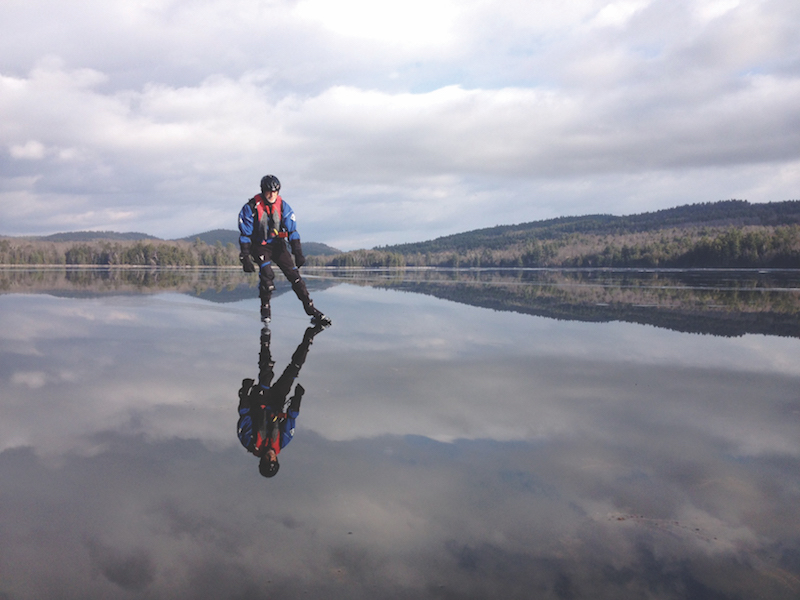
A few years ago, Dill hiked to Sterling Pond on Stowe’ s Spruce Peak after seeing a promising weather forecast. “We were hiking and happened to have our skates with us. We found black ice thick enough to skate on, and it was incredible,” said Dill. He and his skating partner made rounds on the pond’s glassy surface as snow began to fall. “It’s this high mountain lake and the views that surround it, the setting, was really special.” It was too snowy to skate the next day.
If you’re looking to get outside and skate on wild ice in a more regulated setting, these early season skating venues could be for you. For ice forecasts and trip reports visit www.lakeice.squarespace.com. For more information about Dill’s group Vermont Nordic Skaters, as well as outings and workshops this season, visit. www.nordicskaters.org.
The Gear You Need
Bob Dill’s advice to anyone heading out on lake ice is to “use your head and carry the right equipment: a throw rope, ice claws and poles. You should also wear some flotation.” Ice claws are small hand-held plastic grips with stainless steel spikes that protrude from one end. They are connected by a strap that is typically worn around the neck while skating. They allow you to gain traction to pull yourself out of the water should you fall through the ice.
A throw bag is a rescue device with a length of rope stuffed loosely into a bag so it can be thrown to a swimmer from shore or thicker, more stable ice. Nordic test poles (Dill recommends an eight-foot ash ice pole for skating) can be used to test the thickness of ice before you skate on it.
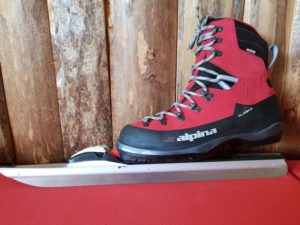
He also recommends using Nordic skates to skate on wild ice. “Nordic skates are just so much more efficient,” says Dill. “They have a longer glide, so it’s easier to go faster than on a figure skate or hockey skate. It’s a real efficient way to move across the ground, like riding a bicycle. It’s just got a nice feel to it.” The boots are also comfortable because they are standard Nordic ski boots that can be fitted with blades. After removing the blades, you can drive, hike and walk around on solid ground in them and, unlike hockey skates, cut through about six inches of light snow without catching an edge.
For newcomers to the sport, Dill recommends a trip to Nordic Skater in Newbury, N.H. Owned and operated by Ben Prime, the shop was the first importer of Nordic skates in the U.S. 19 years ago. For new skaters, Prime recommends an Isvidda Nordic skate blade and platform. Traditionally, the skates feature a blade and Nordic skate ski binding; however, Prime says he sees more and more and more skaters using NNN backcountry touring bindings and Nordic touring boots. “Those are popular because then, you can use the same boots to ski into a backcountry destination and then swap your skis for skates to skate a lake.” For more information about equipment, visit nordicskater.com.
This story was last updated on January 8, 2020.
Featured Photo Caption: Skaters take to the ice on Mirror Lake in Lake Placid, N.Y. Photo courtesy lakeplacid.com.

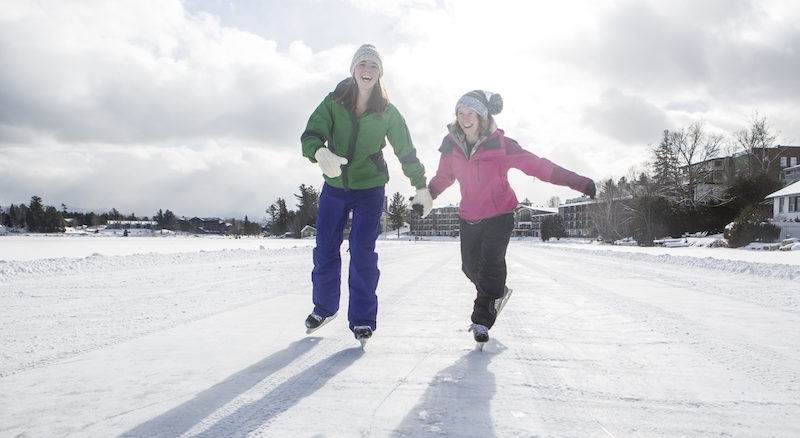
Pingback: Your Winter Bucket List – VT SKI + RIDE